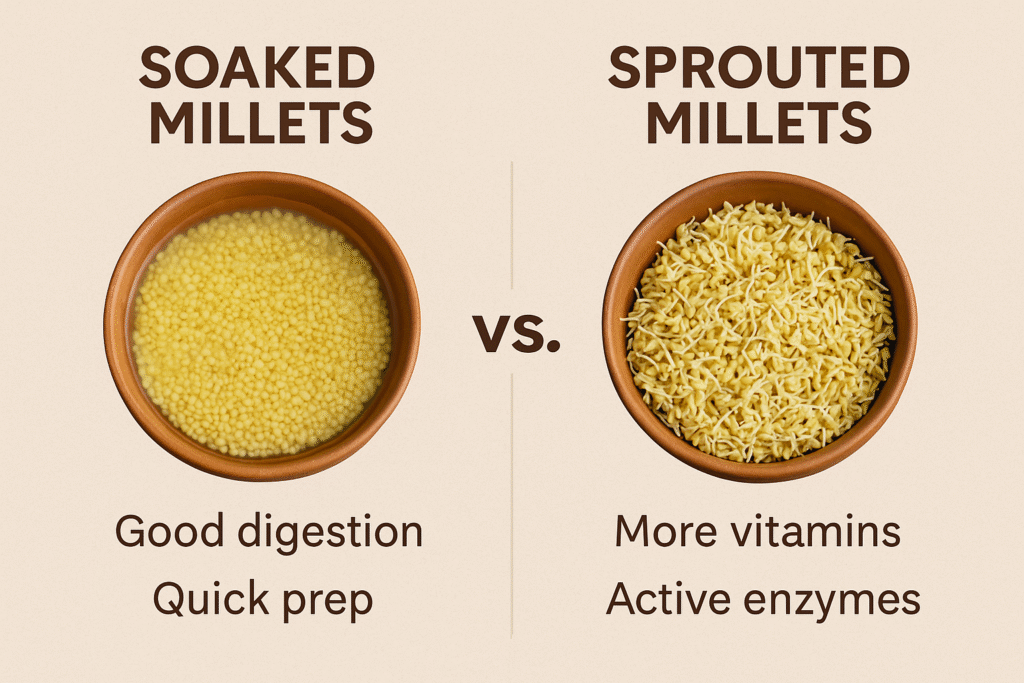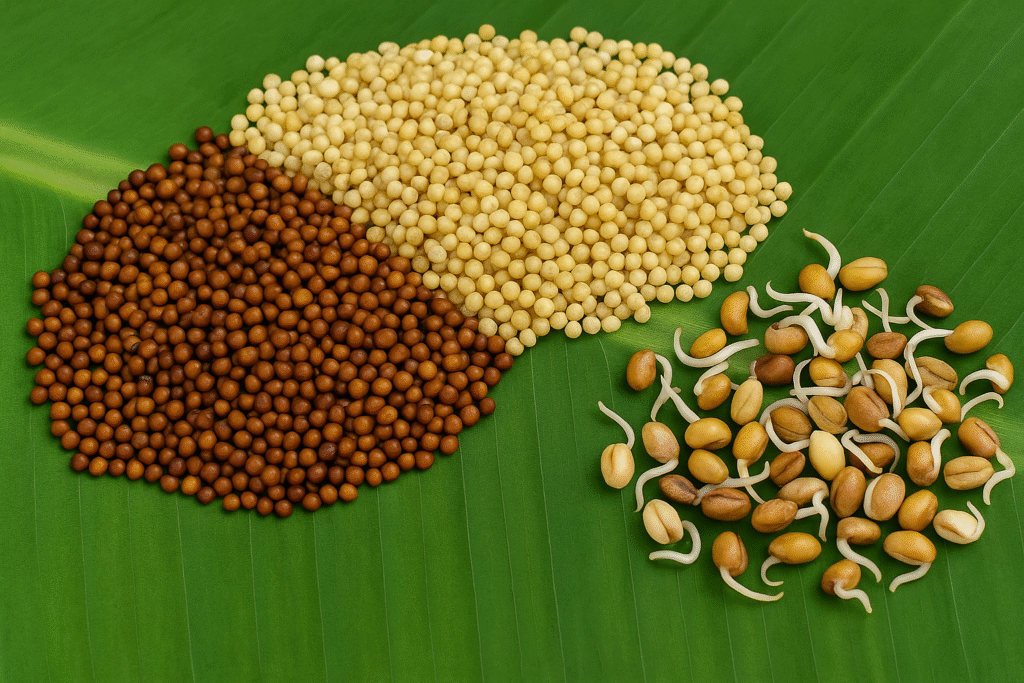Millets have made a strong comeback in Indian kitchens lately. From busy office folks to fitness lovers, everyone’s curious about sprouted millets and soaked millets. Both methods change how your body uses the nutrients inside these tiny grains.
Indian grandmothers always had their tricks — soaking bajra before grinding or sprouting ragi for kids’ porridge. Today, science backs what they knew long ago. Both techniques boost millet nutrition, but each works differently. Let’s talk about how they affect digestion, taste, and your overall health — in plain, easy words.
What Happens When You Soak Millets and How It Helps Your
Soaking millets is simple — you drop them in water, leave them overnight, and wake up to soft, ready-to-cook grains. That small step removes phytic acid, a compound that stops your body from absorbing iron, calcium, and zinc.
In Indian homes, soaking has been the go-to method for recipes like foxtail millet upma, bajra khichdi, or little millet pongal. It makes the grains easier to cook and digest while keeping their natural flavor.
You don’t need to overthink it. Just soak your millets for 6–8 hours and you’re set. The taste stays earthy, the texture gets fluffy, and digestion becomes smoother. It’s the easiest way to get more from your grains without making life complicated.
How Sprouting Transforms Millets into Tiny Nutrition Bombs
Sprouting starts after soaking. You drain the water, wrap the grains in a damp cloth, and let them rest for a day or two. Soon, you’ll see small white tails — that’s when the grains come alive.
Sprouting wakes up the enzymes that convert starch into simpler sugars and boost vitamin C and B–complex vitamins. These nutrients improve gut health and make the millets easier for your body to digest. The flavor shifts slightly too — a bit sweeter, nuttier, and softer.
If your stomach often feels heavy after meals, sprouted millets can really help. They’re lighter, more nutritious, and taste better in dishes like ragi malt or sprouted bajra salad. It’s nature doing half your digestion work before you even eat.

Nutritional Comparison Between Soaked and Sprouted Millets
| Nutrient Aspect | Soaked Millets | Sprouted Millets |
| Phytic Acid Reduction | Medium | Very High |
| Digestibility | Good | Excellent |
| Vitamin C & B Levels | Slight | Strong |
| Cooking Time | Short | Shorter |
| Taste Profile | Mild | Nutty, Slightly Sweet |
| Shelf Life (in Fridge) | 2–3 days | 1–2 days |
Both improve nutrition, but sprouted millets have a higher enzyme activity and better vitamin profile. Still, soaked ones are faster and suit tight schedules.
How Soaked and Sprouted Millets Support Better Gut Health
Your gut loves foods that are easy to break down, and sprouted millets do just that. They’re pre-digested in a way, making them gentle on the stomach. Soaked millets, while not as light, still help by reducing anti-nutrients that cause bloating.
If you’re someone with IBS, gluten sensitivity, or poor digestion, sprouted options like ragi or foxtail millet can be your go-to. But for regular cooking, soaking works great. Both fit the Indian plate—one for energy, the other for ease.
Protein, Fibre, and Mineral Retention Differences
Sprouted millets pack better protein quality and more bioavailable amino acids. This means your muscles and energy get a better boost. The fibre in both helps manage appetite, though sprouting adds antioxidants and minerals that make it more nutrient-dense.
If you’re watching your weight or following a vegetarian diet, sprouted millets are slightly ahead. But soaked millets still do a fine job for energy-packed, filling meals without the hassle of sprouting every batch.
Regional Indian Practices Of Soaking and Sprouting Across States
India’s millet habits go way back. In Karnataka, sprouted ragi malt is a breakfast staple. In Gujarat, families soak bajra for soft, earthy rotis. Down south, Tamil Nadu kitchens use soaked foxtail millet for dosa batter and fermented dishes.
These aren’t trends—they’re habits passed down because they worked with our soil, weather, and diet. Sprouting and soaking made grains lighter for our digestion in hot climates. It’s old-school science that’s still spot on.
Which Method Fits Your Lifestyle and Daily Meal
If you’re tight on time, soaked millets are your best friend. They fit weekday cooking perfectly—easy, fast, and still full of fibre. For those with a bit more patience and a focus on nutrition, sprouted millets bring extra benefits and flavor.

A simple hack—alternate between both. Use soaked millets for your daily khichdi or pulao, and switch to sprouted ones for smoothies, salads, or breakfast bowls on weekends. Keeps things fun, healthy, and balanced.
Simple Step-by-Step Guide to Soak and Sprout Millets
To soak:
- Rinse 1 cup of millet well
- Add 3 cups water
- Leave for 6–8 hours
- Drain before cooking
To sprout:
- Soak, then drain completely
- Wrap in clean muslin cloth
- Keep in warm corner for 24–36 hrs
- Rinse every 12 hrs to avoid spoilage
Store in the fridge for 2–3 days. Add to salads, porridges, or batters—it’s that easy.
Also Read: How to Sprout Millets at Home for Maximum Nutrition?
Conclusion
There’s no wrong pick here. Soaked millets are ideal for busy days and still improve millet digestion and mineral absorption. Sprouted millets go one step further by increasing vitamins and enzyme activity.
For most Indian kitchens, switching between the two works best. Both make millets lighter, tastier, and more nutritious. So whether you’re cooking soaked bajra upma or sprouted ragi porridge, you’re feeding your body something wholesome and rooted in Indian tradition.

